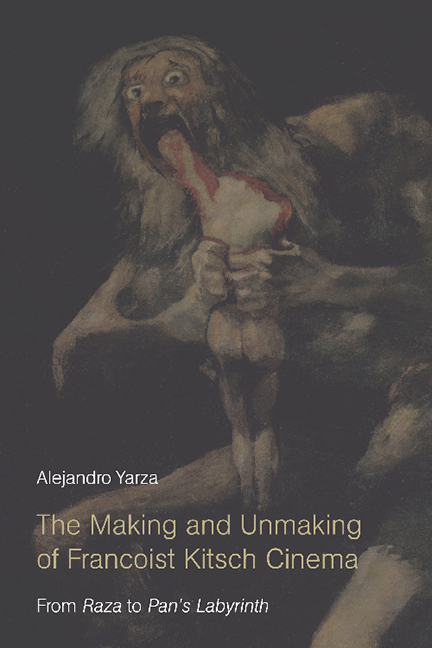Book contents
- Frontmatter
- Contents
- List of Figures
- Acknowledgments
- Preface
- Introduction
- 1 The Petrified Tears of General Franco: Kitsch and Fascism in José Luis Sáenz de Heredia’s Raza
- 2 Romancero Marroquí and the Francoist Kitsch Politics of Time
- 3 Los últimos de Filipinas: The Spatio-temporal Coordinates of Francoism
- 4 Surcos: Neorealism, Film Noir, and the Puppet Master
- 5 Franco, Ese Hombre: From Kitsch-Artist to Kitsch-Man
- 6 Viridiana: The World, the Flesh, and the Devil
- 7 Balada Triste De Trompeta: Of Ghosts and Clowns
- 8 Under the Sign of Saturn: The Labyrinth of Moral Choices in Francoist Spain
- Works Cited
- Index
3 - Los últimos de Filipinas: The Spatio-temporal Coordinates of Francoism
Published online by Cambridge University Press: 10 November 2020
- Frontmatter
- Contents
- List of Figures
- Acknowledgments
- Preface
- Introduction
- 1 The Petrified Tears of General Franco: Kitsch and Fascism in José Luis Sáenz de Heredia’s Raza
- 2 Romancero Marroquí and the Francoist Kitsch Politics of Time
- 3 Los últimos de Filipinas: The Spatio-temporal Coordinates of Francoism
- 4 Surcos: Neorealism, Film Noir, and the Puppet Master
- 5 Franco, Ese Hombre: From Kitsch-Artist to Kitsch-Man
- 6 Viridiana: The World, the Flesh, and the Devil
- 7 Balada Triste De Trompeta: Of Ghosts and Clowns
- 8 Under the Sign of Saturn: The Labyrinth of Moral Choices in Francoist Spain
- Works Cited
- Index
Summary
The moon shone down on everything with that simplicity and serenity which no other light possesses
—Franz Kafka, The TrialThe religious character that was one centrally defining quality of Francoist cinema was envisioned as early as 1935 by Ernesto Giménez Caballero, Franco's future first director of propaganda. In El cine y la cultura humana, he wrote, “[c]inema has found its scientific path: its commercial and spectacular expansion: its political function. But there still remains a last and decisive step: to be on God's side. Will this be the spiritual mission of Spain regarding cinema?” (33).
Director Antonio Román's 1945 film Los últimos de Filipinas [Last Stand in the Philippines]—hereafter Los últimos—is exemplary of the kind of Spanish cinema Giménez Caballero envisaged. The film focuses on the fierce resistance of a besieged Spanish garrison inside a church. Set in 1898, against the general backdrop of the Spanish-American War and the ensuing loss of the remnants of the Spanish Empire, Los últimos represents Francoist cinema's attempt “to be on God's side.” It tries to redeem a humiliating loss by recapturing through violence the Catholic “spiritual essence” that, for conservative Spanish intellectual Ramiro de Maeztu, was the truth of Hispanidad.
As Raza did a few years earlier, Los últimos portrayed Hispanidad by reinterpreting one of the bleakest episodes of Spanish history according to Francoist notions of heroism and redemptive violence. The film was a vehicle through which these Francoist notions could be effectively expressed.
Like Raza, Román's film offered a perfect vignette of Spanish heroism, in this case enacted by a group of Spanish soldiers who, trapped inside an isolated church in the Philippines, were willing to sacrifice their lives in defense of one of Spain's last colonies. And as in Romancero marroquí—whose highly stylized visual representation of Spanish- Morocco was symptomatic of Francoist kitsch aesthetics and ideology— the film's portrayal of a besieged colonial church standing defiantly against a Tagalog rebellion in the small town of Baler transformed the colonial reality of the Philippines into a political myth that condensed Francoist kitsch ideology to perfection.
- Type
- Chapter
- Information
- The Making and Unmaking of Francoist Kitsch CinemaFrom Raza to Pan's Labyrinth, pp. 60 - 101Publisher: Edinburgh University PressPrint publication year: 2017



